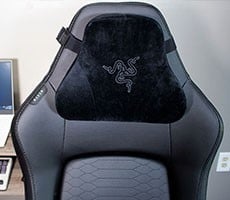|
Razer Iskur V2 Gaming Chair: MSRP $649
Razer's Iskur V2 gaming chair is easy to assemble and offers an adjustable built-in lumbar support system that can pay off if you take the time to find your sweet spot.
|
|
|
- Sleek Design
- 4D Adjustable Armrests
- Looks And Feels Premium
- Generous Recline Angle (Up To 152 Degrees)
- Comfortable Density Foam Cushion
- Integrated And Fully Adjustable Lumbar System
- Cloth Option Available
|
- Seat Lenght Feels A Tad Short
- Finding The Sweet Spot Takes Some Tinkering
- Can We Get Memory Foam Armrests, Please?
- Premium MSRP
|
|
One of the unsung heros of a gaming setup (or any other kind of PC battle station) is the seating. While standard and/or
ergonomic office chairs were the norm for a long period of time, stylish and functional gaming chairs have permeated the marketplace over the past several years, and buyers will now find no shortage of options at a wide variety of price points. One of those options is Razer's new Iskur V2 with a built-in and fully adjustable lumbar system.
As the V2 designation implies, this is a second-generation model of the Iskur and is one of three main options within Razer's 'Lifestyle' category, the others being its mesh Fujin lineup and plush Enki range of chairs. These all cater to different use cases—Razer says its Fujin chairs are for users who want a throne with breathability, the Enki is designed for all-day comfort, and the Iskur (V1 and now the V2, which it introduced at this year's Consumer Electronics Show) is built to deliver ergonomic support.
Razer calls the Iskur V2 the "pinnacle of gaming comfort with unmatched lumber support." A bold claim for sure, and on paper, the Iskur V2 has a lot going for it, including more adjustment options than you'll typically find on a gaming chair. But can it live up to the hype? Pop a squat with us and let's find out...
Razer Iskur V2 Design And Build Quality
Razer offers the Iskur V2 in three trims, including all-black and black/green colorways made from EPU-grade leather, and an "ultra-soft, spill resistant" fabric model that's dark grey. In my experience with gaming chairs, fabric models are a bit more comfy, but non-fabric chairs are easier to clean. With that in mind, I requested the black and green model, which is arguably the most stylish of the bunch (especially if you're a Celtics fan like myself and love anything green). Instead, I received the all-black model, which is still a slick-looking chair and perhaps a little sleeker without the green trim.
Here's a high-level overview of the chair's specifications...
According to the specs, the Iskur V2 supports a body weight of up to 300 pounds and is suitable for a height range of about 5'3" to just under 6'9" via its class 4 gas lift. In other words, whether you're on the shorter or taller side, and/or lighter or stocky, Razer rates the Iskur V2 as being a good (adjustable) fit. For reference, I'm right at around 5'9" and within the weight limit.
Compared to the
Corsair TC100, our most recent chair review before this one, the Iskur V2 is more flexible in the types of body styles (height and weight) it supports. Fit wise, I found the Iskur V2 accommodating without any glaring quirks, which is to say it didn't feel too big or too small, or too anything.
The Iskur V2 is a heavy chair, hence why the instructions recommend enlisting a second set of hands to help with assembly. With or without a partner, however, the Iskur V2 is incredibly easy to piece together. The numbered instructions are straightforward with clear sketches of each step, it comes with the only tool you'll need (as well as a set of black gloves with green trim and some Razer badges), and everything lines up the way it should. It took less than 30 minutes from unboxing to full assembly, and that was with taking my time and snapping a few pictures along the way.
All assembled, the Iskur V2 is stylish with a definite gamer vibe (minus the RGB). Of course, many gaming chairs share a similar overall design language language that borrows from the car racing scene, though the patterned stitching and Razer's logo on the headrest help the Iskur V2 stand out a bit from the competition.
The real distinction, however, is the level of control, especially with the built in lumbar system. There are turn dials on each side of the seat to independently adjust the height and depth of the lumbar support. The dial on the left side lets you raise and lower the height the lumbar support, while the dial on the right adjusts the depth.
The dials themselves are aesthetically pleasing with Razer's logo visible on each one, along with a grooved rubber lining for an easy grip. They lend a sort of high tech vibe to the Iskur V2, and they feel solid to boot—it never feels like they're going to break or wear down even with an overly sturdy grip and aggressive dialing.
As for the lumbar support itself, it's designed to swivel with your body's lateral movements. This sounds great in theory, as it can twist along with your back if you're not the type to sit still. In practice, I didn't find that it was a game changer. In fairness, there's no option to disable the swivel feature, so it's hard to say how it might compare to a static lumbar support system on this particular chair design. But you can feel it move with your back and, after trialing it, is something I'd rather have than not have, but probably wouldn't miss if it didn't move.
The lumbar system is really the main feature of the Iskur V2. It's also the one that, in my testing, required a break-in period. Not for the chair itself, mind you, but for my body. I admittedly have bad posture and often find myself slumping on the couch while watching TV. While it may feel comfortable in the moment, it's brutal over time and can lead to back pain (which I also have—getting old is fun, folks!).
It took me several days to get used to the Iskur V2, as well as frequent fine tuning to find the sweet spot. In the end, I settled on a mild protrusion, though perhaps over time I can slowly adjust it outward as my back adjusts. Once I got past the initial break-in period, I found the Iskur V2 to be mostly comfortable, with the side benefit of training better posture. Whether the training aspect is intentional or not doesn't matter—it's there, and I find myself sitting in a more ergonomic position on the Iskur V2 than on other chairs.

Beyond the lumbar system, you can also adjust the recline with a sturdy plastic handle, all the way back to 152 degrees (up from 139 degrees on the V1). You could take a power nap in this thing if you really wanted to, while resting your head on the large and soft memory foam pillow. Even without adjusting the recline, you can lean back a good distance, and the backrest will spring back into place as you lean back up and forward. Of course, you can also lock it in place so that it doesn't lean, if you prefer.

The 4D armrests also provide flexible adjustments. A metal thumb button on the inside front of each armrest enables you to swivel and push the them back and forth, while a metal paddle on the outside lets you adjust the height. Furthermore, there's a plastic button around the middle of the inside that offers a width adjustment. The bar holding the armrests doesn't move, so this is more of an adjustment of how wide apart you like to have your arms, versus giving you a wider bucket section.
My only real complaint about the armrests is that they follow the same semi-padded construction as pretty much every other gaming chair. They have a slight squish to them, hence why they're pitched as being padded, but it's a hard padding. Perhaps as a result of bad posture, I developed left elbow pain in my previous chair from leaning on it every day. I remedied this by picking up a set of memory foam pads for around
$19 on Amazon. I wish chair makers would offer a memory foam option or include a set of pads, but in lieu of this feature request, they're an affordable DIY add-on.

I never sat in the Iskur V1, but Razer tells me it reduced the seat flanges and side bolsters, and widened the base on the Iskur V2, which it says can better accommodate more seating positions. Surprisingly, my first impression when sitting down was that the bucket felt a little short, even though I'm on the shorter-to-average size myself. That's a result of the lumbar system taking up some space, as it naturally pushes you forward a bit, even when set at its lowest level.
That's part of what I said earlier about there being a break-in period. I actually came to appreciate this as time went on, as there was a noticeable difference in my posture between sitting on the Iskur V2 and plopping into a gaming chair that doesn't have an integrated lumbar support (Maingear's Forma R, for reference, which comes with a separate pillow for lumbar duties).
The seat itself is something I'd rate at a medium firmness level. It doesn't feel like you're sitting on a plush cloud, nor does it feel hard like a rock. Again, Razer offers a fabric version for users who prefer a softer feel.
Razer Iskur V2 Gaming Chair: The Verdict
Part of the challenge with writing reviews is to balance the objective with the subjective, and that's especially true when it comes to gaming chairs, which have to take into account full body comfort. So, let me start with the former. Objectively, Razer's Iskur V2 has a lot going for it. It's sleek and gamer-centric without being gaudy, it offers a plethora of adjustments, and it feels sturdy, save for the plastic casing on both sides beneath the bucket seat.
Not everything about the Iskur V2 is unique—most gaming chairs seem to follow the same or similar overall design blueprint, with companies adding their own custom bits, be they for aesthetics, ergonomics, or both. In this case, Razer's big selling point is the integrated and adjustable 6D lumbar system, with dials on either side to raise or lower the curve, and adjust how pronounced it is. And it swivels, so that it follows the motion of your back as you lean from one side to the other.
Subjectively, I found the Iskur V2 became increasingly more comfortable the longer I used it. My initial impression was that it felt like it was pushing me forward and putting pressure into my lower back. Over time, however, my body's posture adapted to the ergonomics that the Iskur V2 was designed to promote. The chair rewards proper posture with a heightened comfort level, but depending on your existing posture, it may not be evident right way.
Therein lies the break-in period for your body, or at least that's been my experience after a couple of weeks of sitting for multiple hours at a time in the Iskur V2 (for work and play). The other key is dialing (literally) into your comfort zone. There's some trial and error involved, and then as your body adapts, you may find that you need to further fine tune the ergonomics. Not just the lumbar system but also the angle of recline and position of the 4D armrests, which are easy to adjust.
What it all boils down to is that proper posture is required to get the most out of the Iskur V2. If you're a bit of a neanderthal like myself, it can take some time to get there. It's all about finding your sweet spot, and when you do, the Iskur V2 pays dividends with an enhanced level of comfort, while making you more conscious of ergonomics even when you're away from your PC battle station.
What about the price? Razer's Iskur V2
sells for $649. That puts it north of some of the competition, such as SecretLab's
popular Titan Evo and a multitude of lesser known makes and models, though it's also well south of Herman Miller's Embody and several of its other models, some of which cost several grand. Ergonomic models tend to carry a premium, Razer's Iskur V2 sits somewhere in the middle. You'll have to decide how much you're willing to spend on a chair, and how much you care about proper posture. That said, I'm promoting the Iskur V2 to 'daily driver' status.























